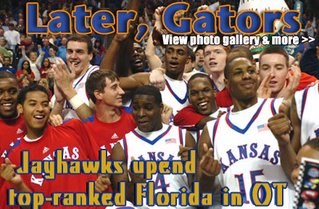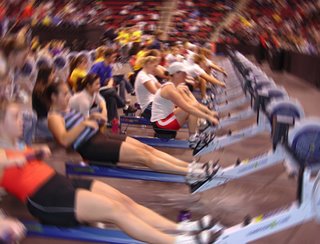Here is some information from US Rowing Coaching education. (see, I really do pay attention when you send me there)
I have finished the workouts for next week and there is both transportation and utilization work. I thought you might like to know what that means.
Physiology for the Not-Too-Scientific, Part I
(this was not written by me but I have edited it for easier reading)
First, we need to understand the aerobic process and how it works in the sport of rowing. Imagine a rowing race. Approximately 80% of the energy required for a 2,000 meter race will come from the aerobic process – the process which uses oxygen to produce energy. Only 20% will come from the anaerobic process, which produces energy without oxygen. So, the aerobic process is the one we are most interested in, and the one in which we can make the most improvement with proper training. If we can develop our aerobic potential, then we can worry about the anaerobic.
In a rowing race, we have two “engines” at our disposal. The aerobic process is the big engine – the diesel. It’s very efficient and economical, but it takes time to start. So, in order to be competitive in a race and start quite fast, we have to switch to a different engine – a smaller, high evolution engine which is not too economical, and can operate for only a short period of time. Why? Because it produces a by-product – lactic acid. Accumulation of lactic acid in the muscles creates stiffness, decreases the ability to perform, and limits the possibility of using the big engine later on.
The race begins. We have to start quickly, so we start the smaller engine – the anaerobic engine – and let it run for about two minutes, while the bigger engine is warming up. After two minutes, the big engine – the aerobic engine – is taking over, and we begin to cruise on diesel. Coming to the end of the race, we want to speed up for that last push, so we switch to the small engine again – just for a short period of time.
Our goal, then, is to increase our aerobic efficiency. There are two components of the aerobic process. Transportation or the ability to get oxygen to the muscle cells to produce energy, and utilization, or the ability to use oxygen in the process which creates energy in the muscle cells. It is very difficult to balance these two systems, especially in training. And there is also considerable controversy among physiologists about which part is more important to the athlete. Both, however, are extremely important to rowers.
The transportation system is really rather simple. We know that the air which we are breathing contains between 20-21% oxygen. Oxygen in the lungs goes to red blood cells (hemoglobin), which is transferred through the veins, to the muscles. The most important component in the entire transportation system is the heart. And, because the heart is a muscle, it can be developed and trained. All of our transportation training methods have the goal of increasing the volume of blood the heart is able to pump with each beat. If you are a well-trained athlete, your heart will be able to pump more blood, bringing more oxygen to the muscles with the same maximum heart rate.
If we want to strengthen the heart, we have to design special workouts. The stimulation has to be quite strong or we won’t notice any progress. In order to develop increased efficiency, stimulations must be very close to maximum – 90-05% of maximum – so that we can push our aerobic limit higher and higher. Translating this to heart rate, it is approximately the maximum heart rate to maximum minus 10 beats. The rule of thumb is figuring maximum heart rate is 220 minus your age. I don’t recommend that people get too involved in stopping to check their heart rates every few minutes. Most people know when they’re close to their maximum output.
How long? Remember that it takes from 90 to 120 seconds to activate the aerobic processes – to “warm up” the big engine. If we use two-minute pieces, then we will be using all of our time for warm up. If we use three minutes, the first two are wasted warming up and then only one minute is used to push the heart. That’s why the classic time is five minutes. As long as the heart rate is kept within the maximum range, we can use anywhere from four to 12 minutes, but five is one of the most efficient. It was for this purpose that we also use pyramid types of pieces as well, where intensity can build gradually and we can avoid an extremely intense first two minutes.
In summary, to increase our aerobic capacity, we must increase the amount of oxygen we’re able to get to the muscles. To do that, we need to train the heart by stimulating it to 90-95% of its maximum. Two workouts especially designed to develop the transportation system are long intervals of four to 12 minutes at high intensity, followed by five to eight minutes of active rest, and short intervals of 20-45 seconds, followed by a brief active rest period (e.g. 20 strokes on, 5 off).
Once an effective transportation system gets the oxygen to the muscles, it is the job of the muscle cells to use the oxygen as efficiently as possible. That process is called utilization.
The goal of any training program is to address both components of the aerobic process – transportation, or the ability to get oxygen from the lungs to the muscle cells, and utilization, or the ability to efficiently use oxygen in the process which creates energy in the muscle cells.
In Part I, we discussed the transportation system and how workouts can be specifically designed to strengthen the heart and therefore bring more oxygen to the muscles. Now we want to address the second component – utilization. Our goal is to deliver as much oxygen as possible to the muscles. Once there, we want the muscles to be able to convert, or utilize, the available oxygen at maximum efficiency.
We accomplish this in two ways.
Improve capilarization – The large tubes are the muscle fibers; the small white cylinders are capillaries.
Capillaries are basically extensions of the arteries. So, since the arteries carry the blood to the muscles, the more capillaries surrounding the muscles, the more oxygen available for them. On the left side you have an untrained person – he has three to four active capillaries around each muscle fiber. He actually has more capillaries, but his regular day-to-day activities require that he only activate three to four. Well-trained athletes will probably require more capillaries, and that is why utilization workouts are so important.
Improve oxidation potential in the muscle cells.
Oxidative potential is improved by increasing the number and size of the mitochondria – “power plants” of the muscle cells – and by increasing the quantity of oxidative enzymes.
Both goals can be achieved by low and medium intensity long-distance workouts. Because we are talking about the muscle system, and very peripheral areas, we have to focus on a very specific group of muscles – the muscles used in the rowing motion. It is highly recommended that utilization workouts be specific rowing motion workouts
This goal can be achieved by low and medium intensity long-distance workouts.
Low Intensity - 60-80 minutes; heart rate 140-160 bpm (65-75% of maximum heart rate); stroke rate 18-24 spm.
Medium Intensity - 45-60 minutes; heart rate 160-175 bpm (70-80% of maximum heart rate); stroke rate 20-26 spm.
These workouts can be done in many different ways, alternating stroke rate and time.
For instance, try 60 minutes of continuous rowing alternating; 4 minutes at 18; 3 minutes at 20; 2 minutes at 22; then 1 minute at 21. These are great workouts for learning rhythm, feeling the boat and improving rowing technique if the rowing stroke is executed correctly.
So...if you made it through this you may understand why we do what we do when we do it...maybe not.









